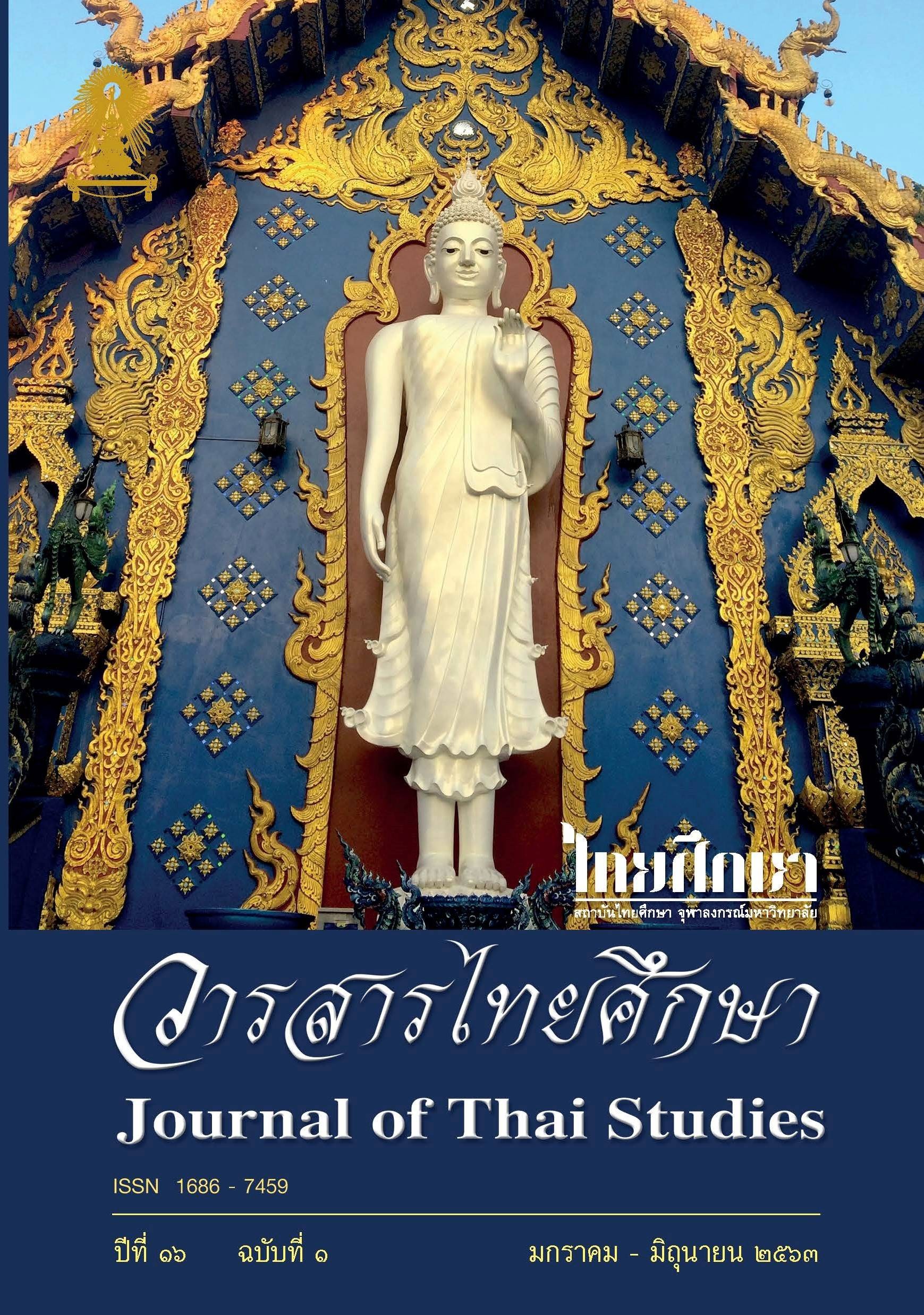Dynamics of Phra Borommathat Chedi folklore in the context of the nomination of Wat Phra Mahathat Woramahawihan to the World Heritage list
Main Article Content
Abstract
This article aims to study the dynamics of Phra Borommathat Chedi folklore and the ways of thinking of how to use folklore in the context of the nomination process of Wat Phra Mahathat Woramahawihan, Nakhon Si Thammarat Province, to the World Heritage List. The study reveals that the use of Phra Borommathat Chedi folklore, such as myths and narratives, beliefs, traditions and rituals in many forms in traditional society, is a main factor in the nomination to the World Heritage List. This has resulted in the use of Phra Borommathat Chedi folklore in various new dimensions. For example, Phra Borommathat Chedi folklore has created new icons and sacred objects, along with instruments to negotiate power relations, and has been transformed into a cultural commodity presented through the academization and expansion of faith and creation of new sacred objects. This phenomenon reflects “the ways of Southern people thinking”, including creating a relationship network, reliance upon the “barami” of Phra Borommathat Chedi, localization and references to cultural roots.
Downloads
Article Details

This work is licensed under a Creative Commons Attribution-NonCommercial-NoDerivatives 4.0 International License.
Journal of Thai studies is licensed under a Creative Commons Attribution-Noncommercial-NoDerivatives4.0 Intenational (CC BY-NC-ND 4.0) licence, unless otherwise stated. Plese read our Policies page for more information on Open Access, copyright and permissions.
References
Bendix, R. (1997). In Search of Authenticity: The Formation of Folklore Studies. Madison: University of Wisconsin Press.
Chupu, N. (2016). The Construction of Sacred Space and The Rituals of Khian Bang Kaew Temple, Khao Chaison District, Phatthalung Province, The 7th Hatyai National and International Conference (pp. 68-89). Songkhla: Hatyai University.
Damsi, W. (2014). Pha phrabot phraratchathan patchai lae sue songsoem suepsan prapheni hae pha khuen that mueang nakhon si thammarat [Royally bestowed Pha phrabot: factors and media promoting the Hae Pha Khuen That Festival of Nakhon Si Thammarat]. Nakhon Si Thammarat: Nakhon Si Thammarat Rajabhat University.
Damsi, W. (2014). Wat phra Mahathat Woramahawihan nakhon si thammarat moradok tham nam su moradok lok phaplak chak wannakam [Wat Phra Mahathat Woramahawihan, Nakhon Si Thammarat, “Moradok tham” leading to world heritage, images from literature]. Nakhon Si Thammarat: Nakhon Si Thammarat Rajabhat University.
Disakun, Y. (2010). Reinvented Traditions and Khlong Hae Community. (Master Thesis). Thammasat University, Bangkok, Thailand.
Hobsbawm, E. and Ranger, T. (1983). The Invention of tradition. Cambridge: Cambridge University Press.
Jaruwon, P. (2016). Khatichon kap kanthongthiao muban watthanatham nong khao changwat Kanchanaburi [Folklore and Tourism: Nong Khao Cultural Village, Kanchanaburi Province]. Bangkok: Faculty of Arts, Chulalongkorn University.
Jenkins, R. (1996). Social identity. London: Routledge.
Kittikan, T. (2014). Mahathat [Mahadhatu]. Bangkok: Matichon.
Kraingu, T. (2016, May 6). phra pit ta phang phra kan samdaeng rit “phae mai pen” [Phra Pit Ta Phang Phra Kan display of might “Cannot lose”]. Khomchatluek. 10.
Nathalang, S. (2016). khatichon sangsan bot sangkhro lae thruesadi [“Creative folklore”: synthesis and theory]. Bangkok: Princess Maha Chakri Sirindhorn Anthropology Centre (Public Organisation).
National News Bureau of Thailand. (2018). Summary of Phra Borommathat Chedi, Nakhon Si Thammarat [website]. Retrieved from http://thainews.prd.go.th/th/website_th/news/news_detail/WNSOC6108050010043/2/10
Nimmanhemin, P. (2002). nithanphuenban sueksa [Study of Folktales] (2 ed). Bangkok: Faculty of Arts Chulalongkorn University.
Nunsuk, W. (2013). Some observations about the origin of the kingdom of Nakhon Si Thammarat. Walailak Journal of Social Sciences. 6(6), 220-263.
Phakdiphasuk, S. (2019). khwamsamphan rawang phasa kap attalak lae naeothang kan nam ma sueksa phasathai [The relationship between language and identity: Guidelines for an introduction to Thai language education]. Bangkok: Chulalongkorn University Press.
Phongphaibun, S. (1999). bucha phraborommathat [Worshipping relics.] In Southern Thai Cultural Encyclopedia (p. 4091-4107). Bangkok: Thai Culture Encyclopedia Foundation Commercial Bank of Thailand.
Rakbanglaem, T. (1997). A study of beliefs and customs related to Wat Phra Mahathat Woramahawihan, Nakhon Si Thammarat province. (Master thesis). Thaksin University, Songkhla, Thailand.
Saengphum, S. (2000). Phranipphansotra: An analytical Study. (Master Thesis). Ramkhamhaeng University, Bangkok, Thailand.
Senchai, S. (2008). Belief and art Jatukaramathep. (Master Thesis). Silpakorn University, Bangkok, Thailand.
The Fine Arts Department. (2017). tamnan phrathat lae tamnan mueang nakhon si thammarat. [Myth of the buddha relics and myth of Nakhon Si Thammarat]. Bangkok: The Fine Arts Department.
UNESCO World Heritage Centre. (2012). Preparing World Heritage Nominations. (S. Phongsatha Posayanan, Trans.). Bangkok: Ministry of Culture
UNESCO World Heritage Centre. (2018). The Criteria for Selection. Retrieved from http://whc.unesco.org/en/criteria/
Wright, Michael. (2007). “Chatukam” (Additional). Art & Culture Magazine. 28(7), 36-37.
Personal Interview
Ngamkhuem, Y. (2018, December 31). Personal Interview.
Ramphuengnit, D. (2018, August 31). Personal Interview.
Thititharo, M. (2018, August 25). Personal Interview.


